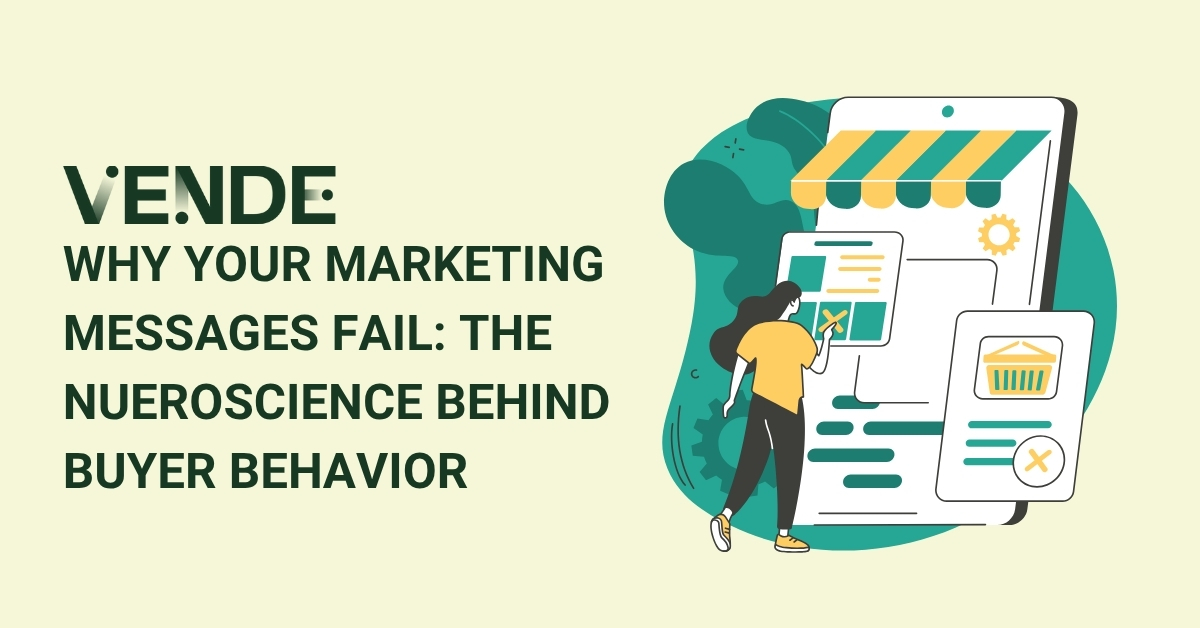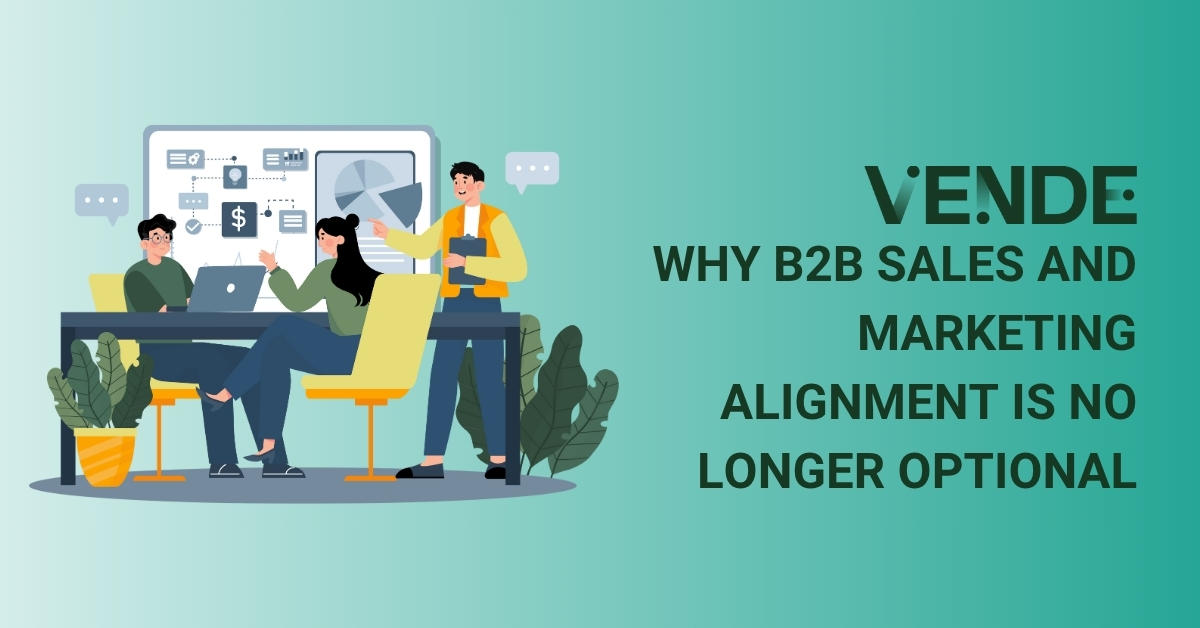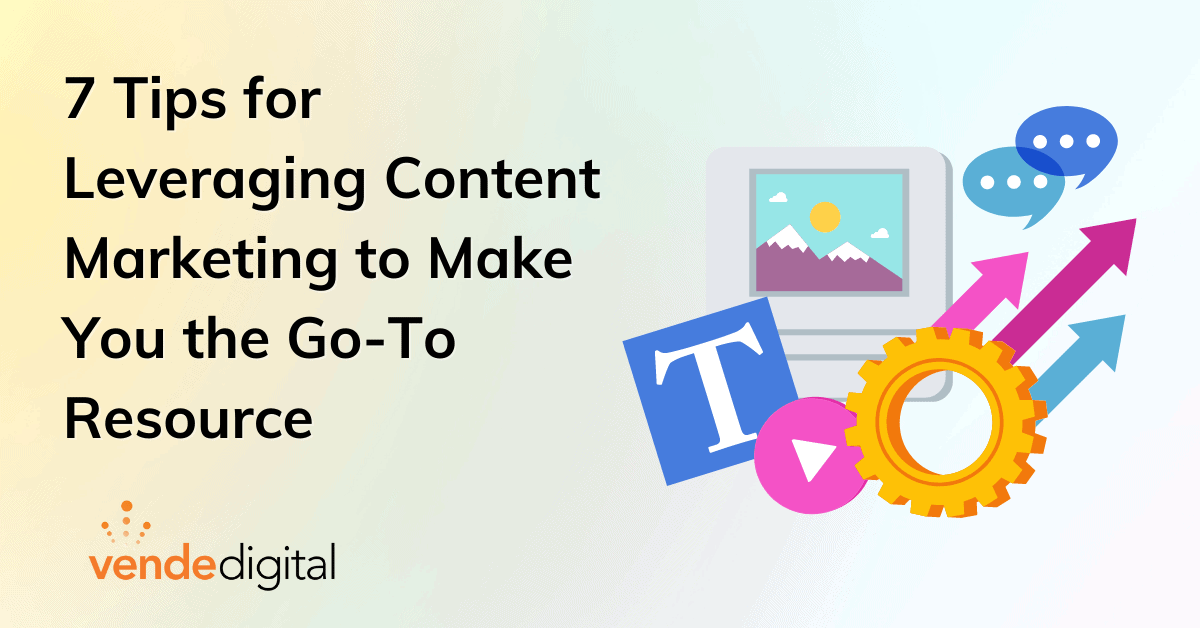
7 Tips for Leveraging Content Marketing to Make You the Go-To Resource for Your Audience
You know that content marketing is a vital part of your overall marketing strategy. However, creating content that resonates with your target audience can be challenging. In this article, we'll provide you with 7 tips for using content marketing to generate B2B demand, helping you become a go-to resource for your audience.
How Can Content Marketing Attract B2B Buyers?
According to Harvard Business Review, modern B2B buyers have a short list of vendors in mind before researching a new solution. Using content marketing to generate B2B demand can attract buyers by providing valuable information that helps them solve their problems and achieve their goals. To be effective, content should be tailored to the needs and interests of your target audience and distributed through the channels they use most.
If you are only focused on selling to your “now buyers,” the reality is that you’re too late. And if you fail to educate prospects with content marketing before they are in the market, you have little chance of convincing them to buy when they’re ready.
Challenges with Content Marketing
Creating content that resonates with B2B buyers is challenging. The internet is crowded with generic, low-quality content that lacks originality and fails to add value. Yet, content marketing is more important than ever for B2B companies. Buyers are on a self-guided tour researching independently and talking to their peers. They are looking for actionable content that focuses on helping them.
Remember, your customer only cares about themselves and their problems. To attract potential buyers, you must produce helpful content that speaks to their needs and interests.
Without actionable content for your customer, there will be little reason for them to consider you a go-to resource. But the flip side of this is a tremendous opportunity! Give them helpful information focused on helping them win, and you will become one of their go-to's when they are ready to purchase your solution.
Content Marketing And Demand Generation
People buy things because of the words they read or hear. Therefore, content marketing is critical to all your demand generation activities. Content marketing enables you to
- Say the right things in the right channels, like social media.
- Use the right words on your website to establish trust and authority.
- Use words that connect with your customer in your emails.
- Say the right things to make customers want to take action.
To become a go-to resource for your audience, you must move away from ineffective old-school ways of content marketing, which involves creating a blog post and hoping it ranks in Google search results. Instead, start with a good strategy that guides your content creation, develop intentional pieces that resonate with your audience, and publish insightful content where your audience spends time online.
The result? Exponentially more customers will interact with your content. This will drive greater value for your customers and ensure you attract buyers in the future. In other words, by adopting the new way of content marketing to generate B2B demand, you can become the go-to resource for your audience, providing them with helpful information that will make them want to keep coming back to you.

Become a Go-To Resource for Your Ideal Customers
If you want to become the go-to resource for your audience, you need to provide value throughout their buyer journey. But why should any buyer visit your website or engage with your content? Follow these 7 tips to capture and hold your buyer's attention from before they are in the market, to making a purchase, to becoming raving fans.
Tip #1: Get Your Content Where Your Customers Go to Learn
You won’t become a go-to resource if you aren’t sharing your content where your customers are spending time, in their preferred channels. Guess what? This isn’t your website.
Building content that lives exclusively on your website assumes people want to visit it to consume your content. This is a bad idea since the primary discovery mechanism for a new prospect would be searching on Google.
Building content for native consumption inside social networks creates greater access, reach, and shareability. It also provides clear user feedback through comments and post engagement. It also has higher exposure, with people logging into these platforms multiple times weekly to get served the content they want.

In the example below, you can see that Vende Digital receives >20X more views from social media than we do on our website. The reality is that the views we receive from social media are also more targeted and aligned with our ideal customers.
These platforms are where B2B buyers connect with their peers and discover new ideas and products. This is where they gain insights and validation about business priorities and purchase decisions.
Publish your information on these platforms in various formats to cater to different learning styles. By being generous with your knowledge and providing valuable information, you can establish yourself as an expert in your field and build trust with your customers.
Tip #2: Kill the Blanket Advice and Help Your Readers Get Quick Wins
Don't settle for providing generic advice that doesn't help your readers. This is what your competition is doing. Instead, create specific, actionable content that addresses gaps in knowledge that matter to your customers.
For example, suppose your competitors provide blanket advice like ‘create more thought leadership content’ but aren’t sharing tips on how to actually do it. In that case, you can take it further and explain how to create thought leadership content effectively.
You establish yourself as a trusted advisor by providing valuable information that your readers can sink their teeth into. Do this by finding gaps in topics that matter to your customers and going a mile deep vs. an inch deep.

You can see in this LinkedIn study on B2B buyer behavior buyers want to know more. They are looking for answers, not fluff. Successful B2B companies are the ones who make their customers smarter and give their audience an edge over their competition. The more you help them find answers and provide actionable advice, the more likely you’ll become their go-to resource, and they will become your customer.
Tip #3: Increase Engagement with Zero-Click Content
We live in an on-demand world. Customers can now choose what they consume and when they consume it. Zero-click content is content you share on social media that provides immediate value for the reader without requiring them to click through to a website or external source.
Share complete and compelling ideas from your long-form web content in a single post or video. Present the key concepts as bullet points to make them more accessible and easier to understand. (See Tip 5 for more information).
They may be on LinkedIn scrolling their feed looking for short practical information or just to pass the time. They don’t want to click over to your site. That’s not why they’re on Linkedin in the first place. Zero-click content means more value for them and less wasted time.
The downside is that zero-click content is hard to track. As marketers, we want to track the ROI of everything we do. Sometimes it's important to be more generous with our knowledge and help people regardless of measurable outcomes. By doing so, we can become a go-to resource for our audience.
Amanda Natividad, VP of Marketing at SparkToro mentions that we need to "freely give away value — insights, tools, templates. Trust that people will eventually buy."
Tip #4: Ungate Your Content, Unleash Your Growth
Most B2B companies still expect their customers “pay” for content by opting in and handing over their personal details to access the company's best content (guides, ebooks, etc.). This creates unnecessary friction for your buyer.
According to a recent study by 6sense, only 3% of B2B buyers will fill out forms on your website. This means that 97% (almost everyone) who visits your website will never see your gated content. In most cases, B2Bs put their best content behind a form, meaning virtually no one sees your best content.
In today's world, you need to remove the walls around your content, or buyers will simply find companies that ungate their content and share their resources freely. This trend will continue to gain traction, and those companies that resist it will simply lose out to their competition, who are adapting to their customer’s new behaviors.
Ungating B2B content can help you increase visibility, build trust and authority, and provide value upfront. You set your company up as a go-to resource by removing barriers to accessing information.
Tip #5: Atomize Your Content to Amplify Your Reach
Atomized content is bite-sized information derived from long-form content, like blogs, guides, case studies, or webinars. It can be repurposed into multiple platforms, providing more chances for engagement with your audience.
By atomizing content, you can be confident that your message and positioning will be unified wherever your audience consumes it. This is vital to becoming a go-to resource for your audience. Marketing is an exercise in memorization, and the more unified your content can be, the more likely your audience will remember you.
Vende Digital uses our monthly Demand Gen Jam sessions as a source of long-form content for atomization. The information we share in our monthly Jam Sessions is repurposed into long-form pieces (blogs and video replays - yep, this article is one of them) stored on our website. These long-form pieces get atomized into micro-content that is shared on other platforms.
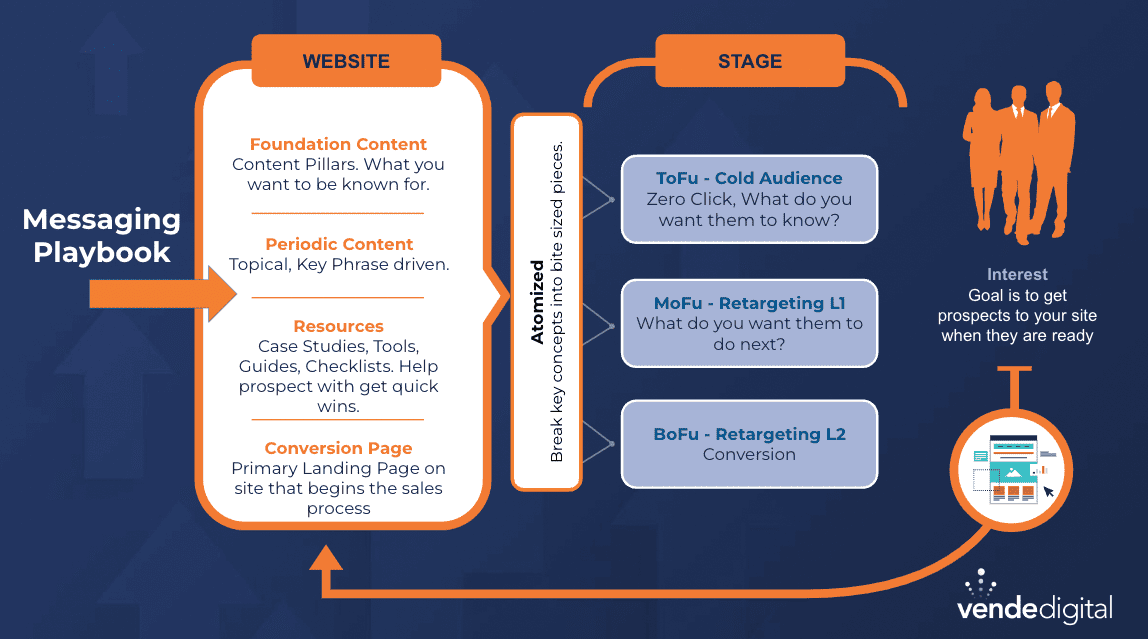
Tip #6: Have a Plan for Ongoing Engagement
Becoming a go-to resource requires moving from a static asynchronous relationship with your audience to something that is more real-time. The goal is to extend your relationship with target customers in a way that allows you to engage in a continuous conversation. Channels like social media, online communities, and webcasts are great examples of how to do this.
At Vende Digital, we've created a community of B2B marketers through our monthly Demand Gen Jam Sessions and Demand Gen Jammers Group. Our focus is on building relationships with our audience and helping them stay current with the latest in B2B demand generation.
By doing this, we're able to transition from being just a brand (Vende Digital) to actual people like Paul Slack, Jess Wood, and Andrea Talamantes, who engage with our audience and share our knowledge. This approach builds trust, making us a go-to resource and putting us on the shortlist when our audience is ready to buy.
Tip #7: Give Your Audience a Plan Forward
Buyers are looking for answers. They want their pain to go away. They want practical, usable information. And it needs to point back to what you do, your products, your services, and your unique selling proposition. Being a go-to resource means pointing them in the right direction to get their problem solved.
But what are the issues that your product solves? How does your solution make their pain go away? What does their life look like once you have? What are the steps they need to take to make their pain go away with your solution? Answer these questions to create a library of topics to write about and weave into your content. This will show your audience that you are qualified to solve their pain and have a plan for when they are ready to move forward.
According to Gartner, buyers wait to talk to sales until they're 80% through decision-making. This means your content needs to help them understand their challenges and provide answers to help move them forward.
It should include how your product can help them achieve their desired outcomes, where to start, and how to move along their journey. And if your content marketing does a good job, your salespeople will simply become order takers, but don’t tell them that!
How to Generate the Best Content For Your Audience
Now that you understand why using content marketing to generate B2B demand is critical to becoming the go-to resource for your ideal customers let's look at an overview of the process.
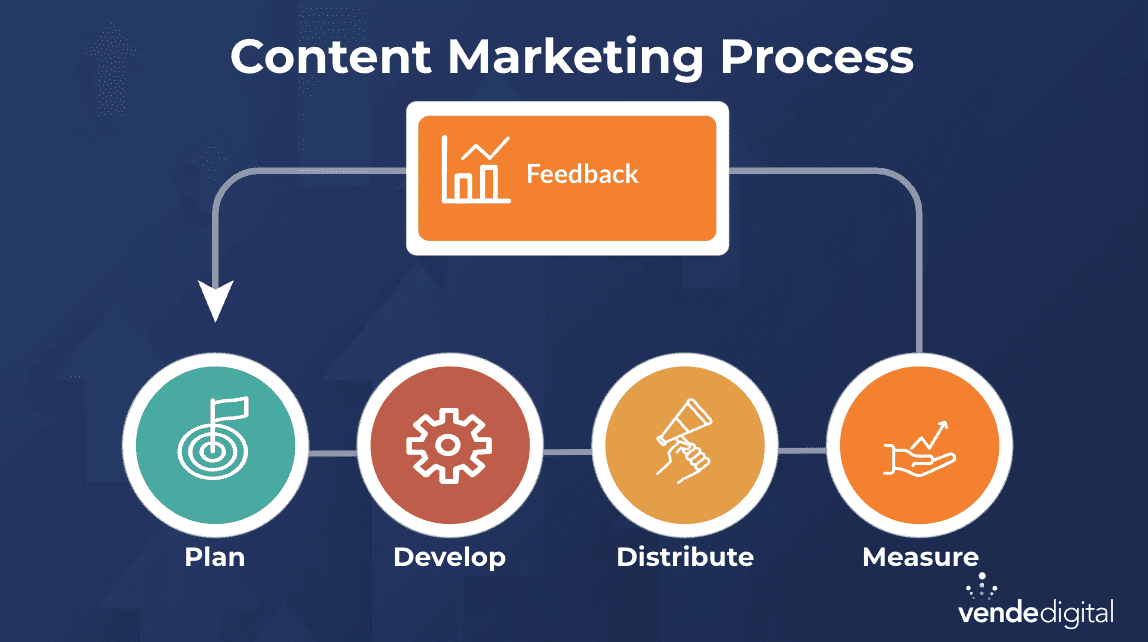
Step 1 - Plan:
During the planning phase, you will conduct thorough research to understand your ideal customers, look at your competitors, and audit your existing content to develop a list of topics and formats that will achieve your goals.
Step 2 - Develop:
In the development stage, you will create relevant content assets for your customers, including blog posts, social posts, long and short-form videos, eBooks, guides, infographics, and more. You will pre-purpose your content and understand how to atomize key points into channel-appropriate micro-content.
Step 3 - Distribute:
The distribution stage is often the most neglected or misunderstood step in the content marketing process. However, it is pivotal in maximizing your reach and content visibility. This will include leveraging social media channels like LinkedIn, Instagram, Twitter, and others (maybe even TikTok), video streaming sites like YouTube and Vimeo, podcast platforms like Spotify and Apple Podcasts, email service providers like Hubspot and Mailchimp, and your website. You must also use paid tactics to amplify your content to ideal audiences.
Step 4 - Measure:
You need feedback to evaluate the performance and effectiveness of your content. Measuring is key to recognizing what content resonates with your audience and which channels provide the greatest return. This can include tracking impressions on posts, podcasts, and videos, analyzing audience reactions, monitoring comments and responses, and measuring leads generated from content.
Key Takeaways for Leveraging Content Marketing to Generate B2B Demand and Become the Go-To Resource for Your Audience
Buyers feel like the content they're interacting with today isn't that useful, helpful, or insightful. And the majority of the content is pretty pitchy.
In an era of unprecedented content saturation, it's crucial to focus on delivering value to your audience to capture and hold their attention. Here are key points to remember to capture and hold the attention of your audience:
- 85% of B2B buyers have a short list of vendors before they are ready to buy. Focus on developing content that establishes your brand as a go-to resource.
- Buyers are on a self-guided research and decision-making tour. They are hungry for knowledge and hate fluff.
- You need to get your content where your customers go to learn, which isn’t your website.
- Only ~5% of buyers are in the market at any time. You need to market to all your customers, not just those in the market.
- Content marketing and demand generation enable you to say the right things in the right channels to create interest in your solution.
- Reduce friction by ungating, atomizing, and supporting the buyer’s journey.
- Start with a strategy to guide your content production. Focus on the distribution of your content while monitoring its performance.
How Can We Help?
The world is changing fast, and being agile is critical to stay competitive in the market. At Vende Digital, we help B2B organizations like you develop B2B marketing strategies to win in the digital-first world.
Tired of struggling on your own?
Schedule a complimentary discovery call with our team to find out how we can help you accelerate your growth and leverage the latest trend to your advantage.


